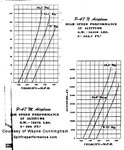Did anybody or could anybody give any info if War Emergency Power on P-47M/Ns reduced power above about 32,000ft so that at a higher altitude military power rating was actually more efficient?
This is a long and interesting thread that may have a Engine Power vs Altitude chart for the R-2800-57(C) but with busy holidays thought it would be worth asking rather then digging through entire thread incase somebody had it onhand.
This is a long and interesting thread that may have a Engine Power vs Altitude chart for the R-2800-57(C) but with busy holidays thought it would be worth asking rather then digging through entire thread incase somebody had it onhand.

